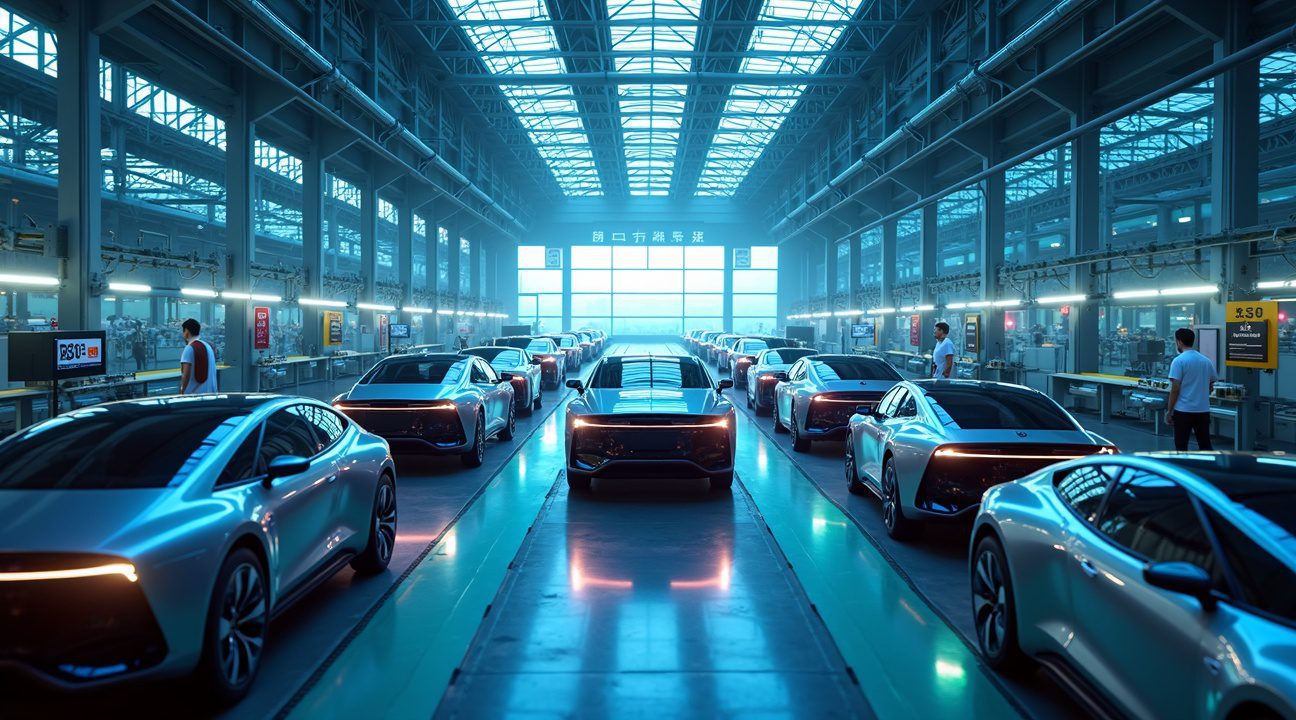BYD’s ambitious Zhengzhou manufacturing complex in China spans an incredible 32,000 acres, making it larger than the entire city of San Francisco and representing one of the most massive industrial projects in automotive history.
This facility demonstrates China’s extraordinary infrastructure development capabilities, progressing from government approval to vehicle production in just 17 months, while creating an estimated $140 billion in economic impact.
Key Takeaways
- Unprecedented Scale: The Zhengzhou factory covers 129.5 square kilometers, exceeding San Francisco’s 121.5 square kilometers and making it more than eleven times larger than Tesla’s Nevada Gigafactory.
- Rapid Development Timeline: Construction began just 37 days after government approval, with operational production commencing in only 17 months from groundbreaking.
- Massive Production Capacity: The facility contributes to BYD’s annual production capability of 5.82 million vehicles, with individual plants like Xi’an producing over one million vehicles in 2024.
- Vertical Integration Advantage: BYD manufactures electric cars, batteries, chips, and semiconductors under one roof, providing a 15% cost advantage over competitors like Tesla through their Blade Battery technology.
- Global Expansion Strategy: Beyond China, BYD operates facilities across Thailand, Hungary, Brazil, and Turkey, with each international plant built for 150,000 annual vehicle capacity.
Monumental Scale and Execution
The Zhengzhou complex stands as a monument to industrial engineering and strategic planning. BYD’s ability to construct and operationalize such a massive facility in under two years showcases the company’s operational excellence and China’s manufacturing infrastructure. This achievement sets new standards for automotive production timelines and scale.
Record-Breaking Output
Production numbers from BYD’s network demonstrate the effectiveness of their expansion strategy. The Xi’an facility alone produced over one million vehicles in 2024, highlighting how individual plants within their network contribute to the company’s global output goals. Each facility operates with precision manufacturing processes that maintain quality while achieving volume targets.
Strategic Vertical Integration
BYD’s vertical integration strategy delivers measurable cost advantages in an increasingly competitive market. Manufacturing batteries, semiconductors, and vehicles within the same operational framework reduces supply chain dependencies and transportation costs. The Blade Battery technology exemplifies how internal innovation translates into market advantages, offering both performance benefits and cost reductions that strengthen BYD’s position against established competitors.
Global Expansion and Standardized Growth
International expansion follows a calculated approach with standardized facility designs optimized for regional markets. Each international plant maintains the 150,000 annual capacity target, allowing BYD to scale production based on market demand while maintaining operational consistency. This standardization reduces complexity in manufacturing processes and enables efficient knowledge transfer between facilities.
Broader Economic Impact
The economic impact extends far beyond vehicle production. BYD’s Zhengzhou complex creates employment opportunities, stimulates local supplier networks, and establishes technology clusters that benefit entire regions. This ripple effect demonstrates how large-scale manufacturing investments can transform local economies and establish industrial ecosystems.
Conclusion: A Global Benchmark
BYD’s manufacturing strategy positions them as a formidable force in global electric vehicle markets. The combination of unprecedented scale, rapid development capabilities, and vertical integration creates competitive advantages that extend beyond traditional automotive manufacturing. Their success in Zhengzhou provides a blueprint for future expansion and establishes new benchmarks for industrial project execution.
BYD’s Massive Zhengzhou Factory Dwarfs San Francisco in Size and Scale
BYD’s ambitious manufacturing complex in Zhengzhou, Henan Province, China represents a stunning achievement in industrial scale and construction speed. I find myself amazed by the sheer magnitude of this project, which spans an incredible 32,000 acres or 129.5 square kilometers. This massive facility actually exceeds the entire land area of San Francisco, which measures 121.5 square kilometers, making it a true testament to modern industrial ambition.
The Zhengzhou complex stands as one of the largest electric vehicle manufacturing hubs globally, dramatically outpacing other major facilities in the industry. Tesla’s Gigafactory in Nevada, previously considered a benchmark for large-scale EV production, covers just 11.7 square kilometers – making BYD’s facility more than eleven times larger. This comparison highlights how Chinese manufacturers are pushing the boundaries of what’s possible in automotive production infrastructure.
Unprecedented Production Capacity and Economic Impact
The economic implications of this facility are staggering, with projected annual output valued at 500 billion yuan, equivalent to approximately $70 billion. However, the broader industry impact extends far beyond direct manufacturing, with estimates suggesting the project could generate up to 1,000 billion yuan ($140 billion) in total economic value. This massive economic footprint positions the facility as a significant driver of regional and national economic growth.
What truly sets this project apart isn’t just its size, but the remarkable speed of development. Construction began merely 37 days after receiving government approval, demonstrating China’s streamlined approach to major infrastructure projects. Even more impressive, operational production commenced just 17 months after groundbreaking – a timeline that would be considered nearly impossible in many other countries. Flying car technology and other advanced automotive innovations may soon emerge from such large-scale manufacturing hubs.
The facility’s rapid development timeline showcases China’s exceptional infrastructure development capabilities and commitment to electric vehicle dominance. I observe that this speed reflects not only efficient planning and execution but also the coordinated effort between government agencies, construction companies, and BYD’s engineering teams. This level of coordination has become a hallmark of China’s approach to major industrial projects, particularly in the electric vehicle sector where the nation seeks to maintain its competitive edge.
From Raw Materials to Finished Cars: BYD’s Vertically Integrated Manufacturing Empire
BYD’s Zhengzhou factory represents a manufacturing revolution that consolidates an entire automotive supply chain under one massive roof. I find this approach particularly impressive because it breaks away from traditional automotive manufacturing models that rely heavily on external suppliers scattered across different locations.
Complete Supply Chain Control Under One Roof
The Zhengzhou facility operates as a vertically integrated manufacturing hub where BYD produces electric cars, batteries, chips, and semiconductors at a single site. This strategy gives the company unprecedented control over every aspect of production, from raw materials to final assembly. Unlike competitors who depend on multiple suppliers, BYD can adjust production schedules, quality standards, and cost structures without external negotiations or delays.
This level of integration proves especially valuable in today’s volatile supply chain environment. When semiconductor shortages plagued the automotive industry, companies with vertical integration capabilities maintained production while others faced significant delays. BYD’s approach ensures they won’t face similar disruptions since they manufacture their own critical components.
Massive Scale Meets Advanced Automation
BYD’s manufacturing capacity across China reached 5.82 million units annually as of 2024, with the Zhengzhou factory contributing significantly to this output. The production process relies heavily on advanced robotic handling systems that maintain both high efficiency and consistent quality standards throughout the manufacturing cycle.
The automation systems I’ve observed in modern electric vehicle factories typically include:
- Robotic welding stations that ensure precise body assembly with minimal human intervention
- Automated battery pack installation systems that handle the delicate process of integrating power units
- Quality control robots equipped with advanced sensors for real-time defect detection
- Automated paint booths that deliver consistent finishes while reducing material waste
- Robotic final assembly lines that can adapt to different vehicle models without significant reconfiguration
This level of automation allows BYD to scale production rapidly while maintaining quality standards that traditional manual processes struggle to achieve consistently. The robotic systems can operate continuously with minimal downtime, maximizing the facility’s output potential.
The chip and semiconductor production within the same facility creates additional efficiency gains. Instead of waiting for external chip deliveries, BYD can coordinate semiconductor production schedules directly with vehicle assembly lines. This synchronization reduces inventory costs and eliminates the risk of production delays caused by component shortages.
Battery production integration offers perhaps the most significant advantage. Electric vehicle batteries represent the most expensive component in any EV, often accounting for 30-40% of total vehicle cost. By manufacturing batteries on-site, BYD controls both cost and quality while reducing transportation expenses and environmental impact associated with shipping heavy battery packs.
The facility’s design accommodates future expansion and technology upgrades without disrupting existing operations. Modular production zones allow BYD to introduce new manufacturing processes or scale up specific component production based on market demand. This flexibility proves crucial in the rapidly evolving electric vehicle market where technological innovations emerge frequently.
Quality control systems throughout the integrated facility use real-time data collection to monitor every production stage. Sensors embedded in robotic systems collect performance data that helps optimize manufacturing processes continuously. This data-driven approach enables predictive maintenance that prevents equipment failures before they impact production schedules.
The vertical integration model also accelerates innovation cycles. Engineers working on battery technology can collaborate directly with vehicle design teams in the same facility. This proximity enables rapid prototyping and testing of new technologies without the coordination challenges that arise when working with external suppliers across multiple locations.

BYD’s Rapid Expansion Across Four Continents
I’ve watched BYD transform from a Chinese battery manufacturer into a global automotive powerhouse with manufacturing facilities spanning multiple continents. The company’s aggressive expansion strategy has established production sites across China, Thailand, Indonesia, Uzbekistan, Brazil, Hungary, and Turkey, creating a truly international manufacturing network.
Establishing International Production Capabilities
BYD’s first wholly-owned manufacturing site outside of China sits in Rayong, Thailand, marking a significant milestone in the company’s global ambitions. This facility demonstrates the company’s commitment to local production with an impressive annual vehicle production capacity of 150,000 units. The Rayong plant serves as a blueprint for BYD’s international operations, proving that Chinese EV manufacturers can successfully establish high-capacity production outside their home market.
The company hasn’t stopped there. I’ve observed BYD systematically building production facilities across key markets, with each new plant designed to produce 150,000 vehicles annually:
- The Szeged, Hungary facility will serve European markets.
- The Camaçari, Brazil plant targets South American customers.
- The Manisa, Turkey location positions BYD strategically between European and Middle Eastern markets.
These facilities are scheduled for completion between 2025 and 2026, representing a coordinated global rollout.
Strategic Market Positioning and Local Manufacturing
BYD’s approach focuses on establishing local production capabilities rather than relying solely on exports from China. This strategy reduces shipping costs, eliminates potential trade barriers, and allows for quicker response to regional market demands. The company even operates an electric bus manufacturing plant in the United States, demonstrating its ability to adapt to different vehicle segments and regulatory environments.
Each facility location reflects careful market analysis and strategic positioning. Tesla’s partnership strategies have shown how global expansion can accelerate market penetration, and BYD appears to be following a similar playbook with its own twist on local manufacturing.
The scale of this expansion rivals some of the most ambitious automotive manufacturing buildouts in history. BYD’s global manufacturing footprint creates production capacity that could potentially exceed 900,000 vehicles annually across its international facilities alone, not counting its extensive Chinese operations.

Record-Breaking Production Milestones Drive Market Dominance
BYD’s manufacturing capabilities have reached unprecedented heights, with production figures that demonstrate the company’s position as a global electric vehicle powerhouse. The automaker’s achievements in 2024 showcase not only impressive scale but also strategic positioning that has reshaped China’s automotive landscape.
Production Capacity That Defines Industry Standards
The Xi’an plant stands as a testament to BYD’s manufacturing prowess, delivering one million new energy vehicles in 2024 alone. This milestone represents more than just numbers—it reflects the company’s ability to meet surging consumer demand while maintaining quality standards across multiple vehicle lines. Four assembly lines at this facility operate with remarkable efficiency, producing between 4,000 to 4,400 vehicles daily. This capacity rivals some of the most established automotive manufacturing facilities globally, positioning BYD among the world’s most productive automakers.
These production levels translate directly into market impact, with BYD’s EV sales for 2024 projected to exceed 4 million units across all facilities. Such volume represents a significant portion of the global electric vehicle market and underscores the company’s ability to scale operations rapidly. The consistency of these numbers also indicates that BYD has mastered the complex logistics required for high-volume electric vehicle production, from battery integration to final assembly.
China’s automotive market has witnessed BYD’s steady ascension, with the company’s market share climbing from 15% to 17% in recent months. This growth trajectory occurs during a period when the Chinese auto market faces increased competition from both domestic and international manufacturers. The sustained expansion demonstrates BYD’s resilience and strategic planning in capturing consumer preference.
Market dominance in China carries significant weight given the country’s position as the world’s largest automotive market. BYD’s ability to increase its share while competitors struggle to maintain their positions reflects several competitive advantages. These include:
- Integrated supply chain management
- Cost-effective production methods
- Products that resonate with Chinese consumers’ preferences
The company’s production milestones create a foundation for sustained market leadership. With manufacturing capacity exceeding 4 million units annually, BYD can respond quickly to market demands while exploring new geographical markets. This flexibility becomes particularly valuable as global demand for electric vehicles continues accelerating, much like how Tesla has partnered strategically to expand its reach.
BYD’s manufacturing success extends beyond raw production numbers to encompass operational efficiency and technological integration. The daily output figures from the Xi’an plant indicate streamlined processes that minimize downtime while maximizing quality control. Such efficiency becomes crucial as the company scales operations to meet both domestic and international demand.
The trajectory from 15% to 17% market share represents more than statistical growth—it signals BYD’s ability to capture market opportunity during a critical period for electric vehicle adoption. Chinese consumers increasingly view electric vehicles as practical alternatives to traditional combustion engines, and BYD’s market position allows the company to capitalize on this shift in consumer behavior.
Production milestones also enable BYD to achieve economies of scale that benefit both manufacturing costs and research and development investments. Higher production volumes spread fixed costs across more units, creating pricing advantages that strengthen competitive positioning. This economic leverage becomes particularly important as the electric vehicle market matures and price competition intensifies.
The combination of million-unit production capabilities, daily output exceeding 4,000 vehicles, and growing market share creates momentum that extends beyond current achievements. These milestones establish BYD as a manufacturing leader capable of meeting future demand while continuing to innovate across product lines and production technologies.

Blade Battery Technology Delivers 15% Cost Advantage Over Tesla
BYD’s revolutionary Blade Battery technology has transformed how the company approaches electric vehicle production, creating substantial cost savings that ripple through its entire manufacturing process. This innovation is particularly impressive because it eliminates the need for traditional battery pack structures while simultaneously simplifying module assembly across multiple vehicle platforms.
Production Efficiency Through Design Innovation
The Blade Battery’s unique design philosophy centers on structural efficiency and manufacturing simplicity. Key advantages include:
- Direct integration into vehicle chassis, reducing assembly complexity
- Elimination of additional cooling systems found in conventional battery packs
- Streamlined production line processes that require fewer manufacturing steps
- Reduced material costs through optimized cell-to-pack ratios
BYD has successfully integrated this technology across several of its vehicle models, creating economies of scale that traditional battery manufacturers struggle to match. The company’s battery production capacity reached an impressive 135 GWh by late 2022, positioning it as one of the largest battery manufacturers globally.
This massive production scale directly contributes to cost advantages that become evident when comparing BYD vehicles to competitors like Tesla’s partnerships. A similarly configured BYD vehicle costs approximately 15% less to manufacture than the Tesla Model 3 produced at Tesla’s Shanghai Gigafactory, according to industry analysis.
The cost differential stems from multiple factors beyond just battery technology. BYD’s vertical integration strategy allows the company to control more of its supply chain, reducing dependency on external suppliers and their associated markups. Manufacturing efficiency gains from the Blade Battery’s simplified assembly process also contribute significantly to overall production cost reductions.
BYD’s approach contrasts sharply with Tesla’s battery strategy, which relies heavily on partnerships with suppliers like Panasonic and CATL. This dependency creates additional layers of cost and complexity that BYD has effectively eliminated through its in-house battery development and production capabilities.
The 15% cost advantage becomes even more significant when scaled across BYD’s expanding production volumes. As the company continues ramping up production at facilities like its massive new factory in China, these per-unit savings translate into substantial competitive advantages in pricing and market positioning.
Industry experts note that BYD’s Blade Battery technology also delivers superior safety characteristics compared to traditional lithium-ion battery packs, further enhancing its value proposition. The technology has passed rigorous nail penetration tests without thermal runaway, addressing one of the most significant safety concerns in electric vehicle design.
This combination of cost efficiency, safety performance, and manufacturing scalability positions BYD’s Blade Battery technology as a formidable competitive advantage in the global electric vehicle market. The technology’s success has already influenced how other manufacturers approach battery pack design and integration strategies.
BYD’s ability to achieve this cost advantage while maintaining competitive performance specifications demonstrates the potential for continued innovation in electric vehicle manufacturing. The company’s integrated approach to battery technology and vehicle production creates synergies that pure-play automakers struggle to replicate without significant investment in vertical integration strategies.

China’s Lightning-Fast Infrastructure Development Reshapes Global EV Competition
The construction of BYD’s massive Zhengzhou factory demonstrates China’s extraordinary ability to execute industrial projects at unprecedented speed. This facility progressed from receiving government approval to beginning initial construction in a remarkable 37 days, then achieved vehicle production startup in just 17 months. Such rapid development timelines showcase the efficiency that has become synonymous with Chinese manufacturing infrastructure.
Speed and Scale Redefining Manufacturing Standards
China’s manufacturing efficiency extends far beyond simple construction speed. The country’s approach to large-scale industrial projects involves comprehensive planning that integrates multiple stakeholders from the outset. Government support plays a crucial role in this process, providing streamlined approval procedures and coordinated resource allocation that eliminates typical bureaucratic delays. This collaborative framework allows companies like BYD to focus on execution rather than administrative hurdles.
The economic transformation occurring within China’s automotive sector reflects broader industrial scaling capabilities. BYD’s evolution from a battery manufacturer into the world’s largest EV manufacturer by production capacity illustrates how Chinese companies can rapidly adapt and expand their operations. The company’s success has generated an estimated industry impact of $140 billion, demonstrating how individual projects can catalyze entire economic zones.
This level of industrial scaling capability positions China as a formidable competitor in global EV markets. Traditional automotive manufacturing hubs now face pressure to match both the speed and scale that Chinese facilities can achieve. Tesla’s partnerships and other international collaborations reflect the growing recognition of China’s manufacturing advantages.
The transformation extends beyond individual companies to encompass entire supply chains and supporting infrastructure. China’s ability to coordinate multiple industrial sectors simultaneously creates synergies that amplify manufacturing efficiency. This systematic approach to industrial development allows for rapid scaling of production capabilities while maintaining quality standards.
Government backing provides the foundation for these achievements, offering both financial support and regulatory streamlining that international competitors often lack. This coordinated approach to industrial development has enabled China to reshape global EV competition by demonstrating what’s possible when manufacturing efficiency receives comprehensive institutional support.
The implications for global automotive markets are significant. Companies worldwide now benchmark their development timelines against Chinese standards, while governments examine China’s industrial policies to understand how rapid infrastructure development can support economic transformation. BYD’s Zhengzhou facility stands as a testament to how manufacturing efficiency can become a competitive advantage that extends far beyond production costs to encompass speed-to-market capabilities that define industry leadership.

Sources:
Future Builds – “BYD Factory”
Automotive Manufacturing Solutions – “BYD Surpassed Tesla Production, Battery Tech 2024”
Supercar Blondie – “BYD Factory Bigger Than San Francisco 2025”
Electrek – “BYD Largest Production Plant: 1 Million EVs 2024”
Wikipedia – “BYD Company”
NDTV – “Video Claims Mega Factory Bigger Than San Francisco China 2025”
CNEV Post – “Exclusive: BYD Production Capacity Stable”
EV Magazine – “BYD AI Scale Global EV Manufacturing 2025”


